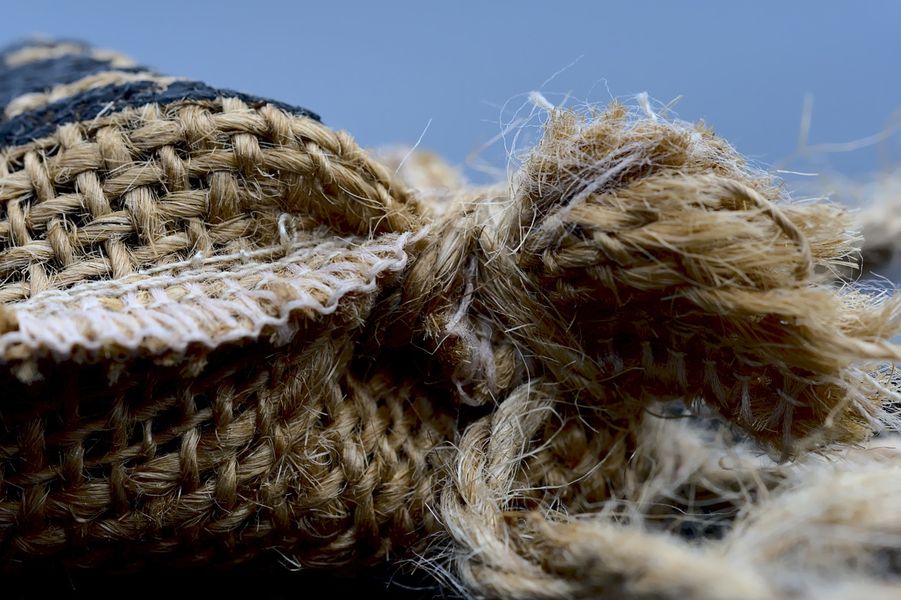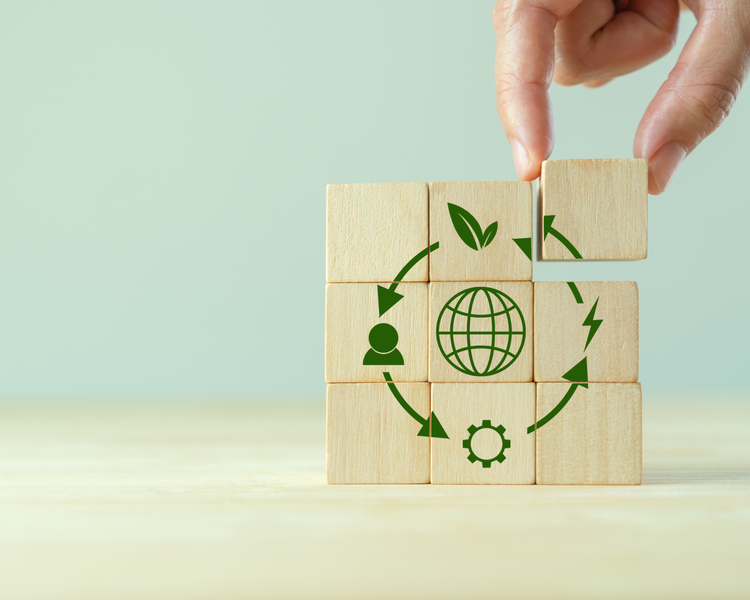As the global textile industry grapples with the environmental consequences of conventional fibre production, hemp (Cannabis sativa L.) is emerging as a sustainable alternative rooted in both tradition and innovation.
Valued for its strong, durable bast fibres, hemp has been used in textiles for centuries, and recent interest has highlighted its complex botanical structure and impressive ecological profile.
From its cellulose-rich composition to its minimal water and pesticide requirements, hemp offers a compelling case for greener fabric solutions. This article explores the botanical and structural characteristics of hemp fibre, delving into its composition, cultivation benefits, processing technologies, and its expanding role in sustainable textile applications.
Main Takeaways
- Botanical Structure and Fiber Composition
- Hemp stalks consist of two main parts: the outer bast fibres (used for textiles) and the inner woody core (hurds). Bast fibres are strong, long, and flexible due to their multi-layered cell wall and chemical composition.
- Sustainability and Environmental Impact
- Hemp requires significantly less water (approx. 2,000L/kg of fibre) than cotton (~10,000L/kg), making it more water-efficient.
- Naturally resistant to pests, hemp reduces reliance on pesticides.
- Improves soil health and supports phytoremediation by absorbing heavy metals.
- Excellent carbon sequestration capacity (up to 22 tonnes of CO₂ per hectare annually).
- Processing Methods
- Traditional processing includes retting, decortication, and scutching to separate and clean fibres.
- Innovations like enzymatic retting, steam explosion, and cottonization enhance fibre quality and processing efficiency.
- Despite advancements, limited processing infrastructure remains a barrier to large-scale adoption.
- Textile Properties and Applications
- Hemp fabrics are highly durable, breathable, moisture-wicking, UV-resistant, and naturally antibacterial.
- Often blended with cotton or synthetics to improve softness and usability.
- Functional enhancements include silver nanoparticle integration for antibacterial effects and CBD infusion for potential wellness benefits.
- Economic and Industrial Landscape
- Hemp reduces agricultural input costs but faces higher post-harvest processing complexity.
- The hemp fibre market is projected to grow significantly, driven by the demand for sustainable fashion and construction.
- Regulatory inconsistencies across regions can limit market potential and investor confidence.
- Future Outlook and Challenges
- Expansion hinges on building scalable processing infrastructure and addressing public misconceptions linking hemp with psychoactive cannabis.
- Continued research and public education are essential to unlocking hemp’s full industrial potential.

Photo By: LATUPEIRISSA
Botanical and Structural Characteristics of Hemp Fiber
Hemp, scientifically known as Cannabis sativa L., is an annual herbaceous plant cultivated for its versatile applications, one of them being in textile production.
The plant’s stalk has two primary components: the outer bast fibres and the inner woody core, known as hurds. Bast fibres are found in the phloem part of the stem and are the primary source of textile-grade hemp fibre due to their length, strength, and flexibility. These fibres are organized in bundles and are characterized by a multi-layered cell wall structure, which contributes to their mechanical properties.
Fiber Composition
Hemp bast fibres have a chemical makeup that affects their physical properties and uses. The main components are:
Cellulose: This makes up about 70–74% of the fiber. Cellulose gives strength and structure to the fibre. A high amount of cellulose helps the fibre resist stress and stay rigid.
Hemicellulose: Making up around 15–20% of the fibre, hemicellulose is a type of carbohydrate that works with cellulose to add flexibility and improve moisture absorption.
Lignin: This complex polymer accounts for about 3.5–5.7% of the fibre. Lignin adds rigidity and helps protect the fibre from microbes. It fills the gaps between cellulose and hemicellulose, increasing fibre’s stability.
Pectin: Present in smaller amounts (~0.8%), pectin acts like a glue, holding fibre cells together. Its breakdown during retting, a process to separate fibres, is important for processing.
Waxes and Fats: These make up about 1.2–6.2% of the fiber. They help make it water-repellent and can affect how well dyes stick to the material.
The exact makeup of these components can change based on the type of plant, its growing conditions, and how it is processed.
Cultivation and Environmental Impact of Hemp
Water and Land Efficiency
Hemp (Cannabis sativa L.) can be very efficient if we think about the use of water and land resources. Studies indicate that hemp requires approximately 2000 litres of water per kilogram of fibre, significantly less than cotton, which demands about 10,000 litres for the same yield. This substantial difference highlights hemp’s potential as a more sustainable alternative in textile production.
Pesticide Use
Hemp exhibits a natural resistance to many pests and diseases. This resilience not only lowers cultivation costs but also minimizes environmental pollution associated with agrochemicals. Research has demonstrated that compounds found in hemp, such as cannabidiol (CBD), possess insecticidal properties, offering potential as natural pest control agents.
Soil Health
The cultivation of hemp can contribute positively to soil health. Its deep root systems improve soil structure, prevent erosion, and promote aeration. Hemp has been identified as a viable candidate for phytoremediation—the process of using plants to remove contaminants from the soil. Studies have shown that hemp can absorb heavy metals like cadmium, lead, and arsenic, thereby detoxifying polluted soils and restoring their fertility.
Carbon Sequestration
Hemp is recognized for its remarkable carbon sequestration capabilities. It can absorb up to 22 tonnes of CO₂ per hectare, surpassing many other crops in carbon uptake. Given its rapid growth cycle, with the possibility of cultivating two crops annually, hemp serves as an effective tool in mitigating greenhouse gas emissions and combating climate change.

Photo By: Nicky
Processing Techniques
Traditional Methods
Producing hemp fabric begins with the cultivation of the Cannabis sativa plant. The manufacturing process initiates with the harvesting of the hemp stalks. These stalks undergo a retting process lasting 4-6 weeks. This important step separates the bast fibres from the woody core, preparing them for further refinement.
Post-retting, the extracted fibres are spun into yarn. Once spun, the hemp yarn is woven using standard fabric-making techniques, resulting in a versatile textile suitable for diverse applications.
- Retting: This process breaks down the pectins binding the bast fibres to the woody core. Traditional methods include dew retting, where stalks are left in the field to decompose naturally, and water retting, which involves submerging stalks in water to promote microbial activity.
- Decortication: Following retting, decortication mechanically separates the bast fibres from the woody core. This can be achieved through manual or mechanical means, depending on the scale of production.
- Scutching: This step involves beating the fibres to remove remaining shives (woody particles) and impurities, resulting in cleaner, more refined fibres suitable for spinning.
Modern Innovations
Advancements in hemp processing aim to improve fibre quality and adaptability for textile applications:
- Enzymatic Retting: Utilizing specific enzymes to break down pectins offers a more controlled and environmentally friendly alternative to traditional retting methods.
- Steam Explosion: This method uses high-pressure steam to disrupt the plant’s structure, facilitating easier fibre separation and enhancing softness.
- Cottonization: A process that modifies hemp fibres to mimic the properties of cotton, making them compatible with existing cotton spinning systems and improving their softness and spinnability.
Challenges
Despite these innovations, hemp processing faces challenges. Unlike cotton, hemp lacks a widespread, industrial-scale processing infrastructure, hindering its scalability in the textile industry.
Also, hemp fibres are naturally coarser and stiffer than cotton, posing difficulties in spinning and requiring additional processing to achieve the desired softness.
Textile Properties and Applications
Durability
Hemp fibres exhibit high tensile strength, making them up to five times stronger than cotton. This durability translates to longer-lasting textiles that withstand wear and tear.
Breathability and Moisture-Wicking
The porous nature of hemp fibres allows for excellent breathability and moisture-wicking properties, keeping wearers cool and dry.
UV and Antibacterial Properties
Hemp fabrics naturally resist ultraviolet light, offering protection against harmful rays. Additionally, compounds in hemp provide antibacterial properties, reducing odours and inhibiting bacterial growth.
Blending with Other Fibers
Combining hemp with fibres like cotton or synthetics enhances the resulting fabric’s texture and usability. Such blends capitalize on hemp’s strength and environmental benefits while improving softness and flexibility.

Photo By: Terre Di Cannabis
Functional Enhancements
Nanotechnology Applications
Incorporating silver nanoparticles into hemp fabrics imparts enhanced antibacterial and UV-protective properties. These nanoparticles disrupt microbial cell membranes and reflect UV radiation, extending the fabric’s functionality.
CBD Infusion
Embedding cannabidiol (CBD) extracts into hemp textiles is an emerging innovation aimed at promoting skin health and providing therapeutic benefits. While research is ongoing, such functionalization could offer added value in wellness-focused apparel.
Economic and Industrial Considerations
Cost Factors
Hemp cultivation offers environmental advantages, such as requiring approximately 50% less water per season than cotton. However, the economic viability of hemp is influenced by several factors. While hemp can reduce agricultural costs by up to 77.63% compared to cotton, the overall cost-effectiveness is affected by the complexity of post-harvest processing, which remains more intricate and less mechanized than that of cotton.
Market Potential
The global hemp fibre market is experiencing significant growth and is projected to expand from $5.76 billion in 2022 to $23.57 billion by 2030. This surge is driven by increasing demand in sustainable fashion and construction industries. Hemp’s versatility and strength make it an ideal sustainable fibre, especially when blended with cotton, which is present in a substantial portion of apparel products.
Regulatory Landscape
The regulatory environment for hemp varies widely, impacting its cultivation and commercialization. In the United States, the 2018 Farm Bill legalized hemp at the federal level, but state regulations differ. For instance, Texas has recently passed legislation banning most hemp products, posing challenges for the state’s hemp industry. Such regulatory inconsistencies can hinder market growth and create uncertainty for producers and consumers alike.
Challenges and Future Outlook
Processing Infrastructure
The hemp industry faces challenges due to a lack of industrial-scale processing infrastructure. Investments are being made to address this gap; for example, Renaissance Fiber has secured funding to enhance hemp fibre refining infrastructure in North Carolina, aiming to strengthen the supply chain from farm to fabric.
Public Perception
Public misconceptions about hemp, often associating it with psychoactive cannabis products, pose challenges for market acceptance. Educational initiatives are necessary to inform consumers about the differences between hemp and marijuana, emphasizing hemp’s non-psychoactive properties and its potential benefits in various industries.
Research and Development
Ongoing research is crucial to fully realize hemp’s potential. Studies are exploring its applications across multiple sectors, including textiles, construction, and biofuels. Institutions like Thomas Jefferson University are conducting research ranging from basic science to product development, aiming to innovate and expand hemp’s industrial uses.
Conclusion
Hemp fibre stands at the intersection of tradition, science, and sustainability. Its unique botanical structure and high cellulose content endow it with exceptional strength, breathability, and environmental resilience—qualities that make it increasingly attractive for textile applications.
As the fashion and materials industries seek alternatives to resource-intensive fibres like cotton, hemp offers a viable solution with significantly lower water and pesticide requirements, the ability to regenerate soil, and remarkable carbon sequestration potential.
Modern innovations in processing, such as enzymatic retting and cottonization, are addressing historical limitations in fiber refinement and scalability. However, challenges remain—including a lack of industrial infrastructure, regulatory hurdles, and persistent public misconceptions.
With growing investment, supportive policy frameworks, and continued research, hemp has the potential to play a central role in building a more sustainable textile economy.



